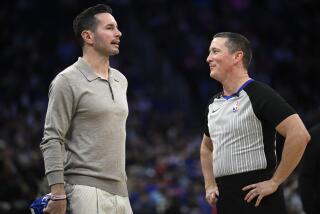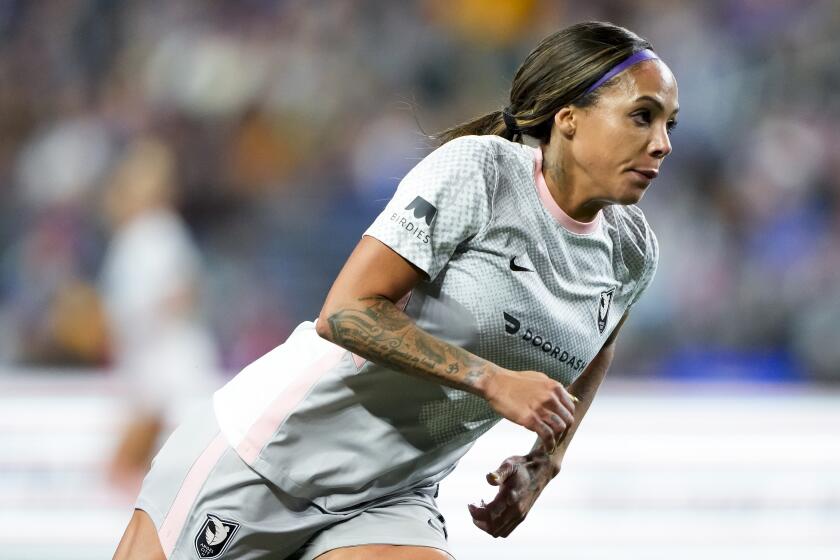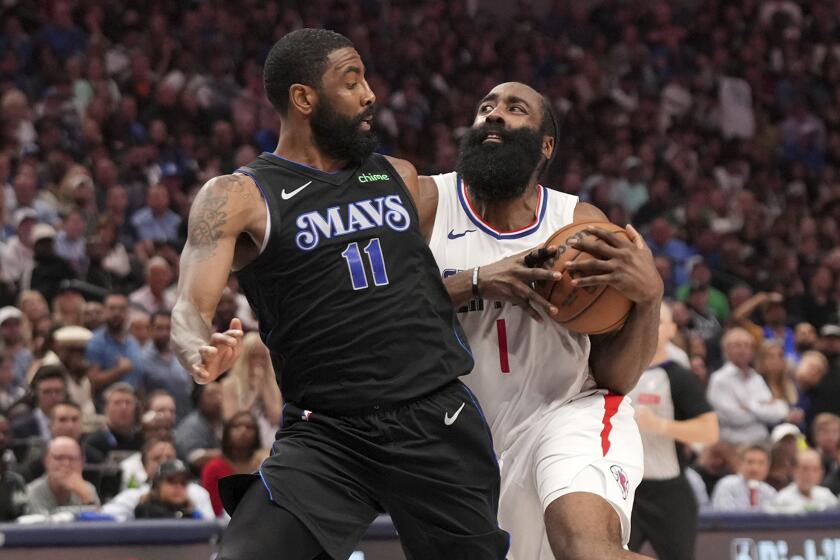Dressed To Kill : High-Tech Equipment Is the Rage
The fall lines are out, and it’s clear that the well-dressed prep player of the ‘80s has gone high-tech. Leather head wear is passe. Flak-jacket style rib protectors and knee braces are the rage.
The modern football player is a product of advanced technology, of studies in biomedical research and new ideas in engineering. Football is risky business and, to reduce the risk, equipment manufacturers have gone into the testing labs and onto the draftsman’s table to produce football gear that can make an average high school athlete look like something out of an H.G. Wells’ novel.
For about $350, approximately what it costs to outfit a prep football player from the top of his helmet to the tips of his cleats, an athlete can step into and strap on gear that has been designed to protect against injuries and provide the confidence it takes to throw one’s body in front of an opposing running back.
A tour, from head to toe:
Helmets, the subject of so many lawsuits that many manufacturers dropped out of the market because of soaring liability costs, have been tested the way the seat belts once were. In-depth lab studies have included testing helmet shells for “impact absorption performance” and “shock depression function.” Helmets can be custom-fitted by inflating an air-filled inner liner that is designed to help absorb the impact of violent collisions.
The result is a helmet that most believe to be the state of the art. Said Dr. Glen Almquist, orthopedic specialist for the Sports Conditioning and Rehabilitation Clinic (SCAR) in Orange: “From the junior high level all the way to the pros, the helmet is excellent now. It’s about the best you’re going to get.”
Facemasks have changed dramatically since the days of the single-bar models that left players wide open for painful nose jobs. The latest face masks are made of a polycarbonate alloy that is used to make the shells of some helmets. Manufacturers say the new masks offer the same protection as the conventional steel masks with rubber coating, but are approximately two-thirds lighter.
There is much more to a set of shoulder pads than foam padding, plastic flaps and snap-on straps. One manufacturer claims to use an “air management system” which is supposed to absorb the shock of contact and disperse it throughout a bone or joint, reducing the risk of fractures. The “Tailoring Concept” also is applied to shoulder pads. Quarterbacks use scaled-down models for more freedom of movement, whereas linebackers are generally fitted in bulky sets because they offer more protection for heavy impact and make for a more intimidating appearance.
Protective ribs pads have become standard equipment for most quarterbacks, and some running backs and receivers have begun using them. Lightweight and adjustable, the manufacturers boast.
Rolls of adhesive tape simply won’t do to protect the fingers and hands of offensive and defensive linemen. Any self-respecting, style-conscious tackle is wearing black leather gloves these days.
Thigh and hip pads are contained in a girdle that is worn under the uniform pants. That used to be the girdle’s only function. Now, girdles are available in an extra-long style that keeps the legs warm and protects against muscle pulls.
A lateral guard isn’t the guy who pulls to lead the sweep. It’s a brace being strapped to an increasing number of players’ knees. Some coaches require their players to wear knee braces. Others say they’re optional. Their effectiveness is the subject of great debate in the field of sports medicine (see accompanying story).
Tape remains the source of support for ankles. High-top cleats are making a comeback. Doubleknits and polyesters are in vogue for pants. And fashionable jerseys are done in mesh this year.
The entire package produces a well-protected player. But, as experts in sports medicine and athletic training stress, helmets and pads can only offer protection. Despite the advancements, they haven’t come up with equipment that prevents injuries.
Warning labels are attached to many of the components of a football player’s protective system. A typical label reads: “Football is a dangerous contact sport which may result in serious injuries or even death. Although our equipment is designed to help reduce the risk of such injuries, there is no guarantee that any injury will be prevented by the use of this equipment.”
Scary stuff, but a necessary disclaimer in an era in which injury-related lawsuits can make the sporting goods business less than profitable. Besides, medical experts agree with that theme.
“One of the biggest problems has always been that the really serious injuries are extremely difficult to protect against,” said Dr. Robert Cassidy, an orthopedic surgeon and one of the founders of the Sports Medical Clinic of Orange County. “You’re really not going to prevent a serious injury (with equipment). It’s done with proper coaching, proper technique and training.
“It’s nice to take a piece of equipment, put it on and say, ‘I’m invincible.’ But that’s not going to happen.”
Added Almquist: “The best preventive equipment that there has been in the last 15 years is the well-conditioned athlete.”
More to Read
Get our high school sports newsletter
Prep Rally is devoted to the SoCal high school sports experience, bringing you scores, stories and a behind-the-scenes look at what makes prep sports so popular.
You may occasionally receive promotional content from the Los Angeles Times.






